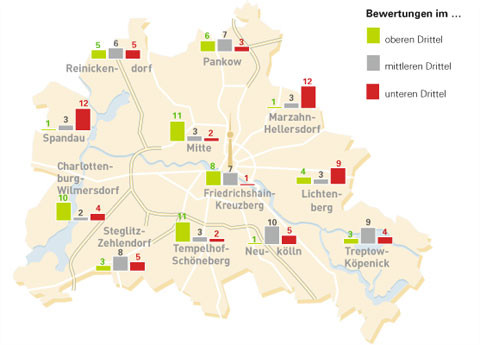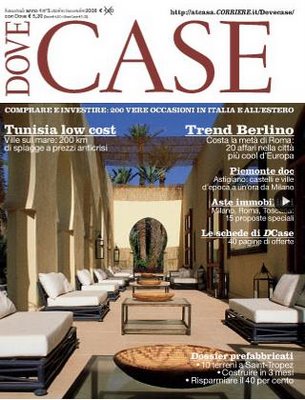We enjoy reading the local press and reportages about each single Bezirk in Berlin, in order to stay tuned with what’s going on in our Kiez also when we’re not in town.

Beim B-max Bezirksvergleich schneiden Mitte und Tempelhof-Schöneberg am besten ab.
Der Stadtteil Mitte verzeichnet seit Jahren reges Bau- und Gründungsgeschehen, viele Unternehmen wünschen sich für ihren Berliner Sitz eine attraktive Adresse im Herzen der Hauptstadt. Es ist daher keine Überraschung, dass Mitte den ersten Platz belegt. Punktgleich mit an der Spitze liegt Tempelhof-Schöneberg. Der Bezirk mit den größten Industrieflächen der Stadt hat fast immer das obere Drittel erreicht.
„Es überrascht mich nicht, dass unser Bezirk so gut abschneidet“, sagt Ulrich Misgeld, Chef des Lichttechnikunternehmens Semperlux. „Wir fühlen uns gut aufgehoben in Tempelhof-Schöneberg.“ Man spüre etwa, dass das Team der Wirtschaftsförderung sehr aktiv sei. Außerdem mache sich bemerkbar, dass sich Bezirksbürgermeister Ekkehard Band (SPD) selbst um die Unternehmen im Bezirk kümmere. „Als wir unser Unternehmensnetzwerk Motzener Straße gegründet haben, hat uns der Bezirk nicht nur mit Worten, sondern auch mit Geld unterstützt“, berichtet Misgeld. Voraussetzung dafür ist, dass der Bezirk für so etwas Geld hat: Im Gegensatz zu manch anderem Bezirk steht Tempelhof-Schöneberg auch in der Haushaltsführung gut da.
Auch Tanja Mühlhans, die sich in der Senatswirtschaftsverwaltung um die Belange der Kreativ-unternehmen kümmert, weiß, dass die sich am liebsten innerhalb des S-Bahn-Ringes niederlassen. „Studien zeigen, dass sie sich in bestimmten Straßenzügen ansiedeln“, sagt Mühlhans. Das ganze werde dann zu einem Selbstläufer. „Viele gehen dahin, wo sie schon andere kennen.“ Das mache auch Sinn. So könnten Synergien genutzt werden. „Die kurzen Wege sind wichtig.“
Möglicherweise werde das Ranking in wenigen Jahren aber auch ganz anders aussehen. Der Flughafen Berlin-Brandenburg werde auch Unternehmen der kreativen Szene nach Treptow-Köpenick locken, erwartet Mühlhans. Schon jetzt wächst in Oberschöneweide eine kreative Szene heran. Größtes Projekt sind die Schauhallen, die in einer ehemaligen Fabrikhalle der AEG entstehen sollen. Auch andere Bezirke sieht Mühlhans in einem Prozess. „Es gibt eine Reihe bei denen man merkt, dass sie mit Herzblut dabei sind.“ Tempelhof-Schöneberg, Pankow und Neukölln gehören für sie dazu.
Wo entstehen neue Jobs, wo werden besonders viele Firmen gegründet? Die Veränderungsprozesse sagen viel aus. Überraschend: Bezirke, die insgesamt sehr gut dastehen, fallen hier zurück.
Berlin hat in den vergangenen drei Jahren insgesamt einen Beschäftigungsboom erlebt, die Zahl der Arbeitslosen sank von 330 000 Anfang 2005 auf zuletzt unter 220 000. Der Zuwachs an Beschäftigung verteilt sich jedoch sehr ungleichmäßig. Mitte, Friedrichshain-Kreuzberg und Reinickendorf haben prozentual das größte Wachstum an sozialversicherungspflichtigen neuen Stellen erlebt. Auf der Verliererseite stehen mit Charlottenburg-Wilmersdorf und Tempelhof-Schöneberg zwei Bezirke, die insgesamt zu den wirtschaftsstärksten gehören. Wieso gerade hier die Zahl der Arbeitsplätze gesunken ist, vermag die Arbeitsagentur nicht zu erklären.
Vom Gründergeschehen profitieren vor allem die Innenstadtbezirke. Den Bezirken mit großen Hochschulen kommen zudem die Ausgründungen von Studenten und Wissenschaftlern zugute. Dabei fällt auf, das Treptow-Köpenick von den naturwissenschaftlichen Instituten der Humboldt-Universität in Adlershof offenbar nicht so stark profitiert hat, wie Steglitz-Zehlendorf von den Ausgründungen der Freien Universität.
Neben der Anzahl der An- und Abmeldungen von Unternehmen spielt natürlich die Qualität der Investitionsprojekte eine Rolle. Denn in der Gesamtzahl der Gewerbeanzeigen sind auch Kleinstbetriebe verzeichnet, die zum Teil nur vom Inhaber gegründet wurden, um eine Phase der Arbeitslosigkeit zu überbrücken. Die Berliner IHK veröffentlicht regelmäßig das Dokument „Neue Firmen – Neue Arbeitsplätze – Neue Investitionen“. In ihr werden Projekte angeführt, die viel Aufmerksamkeit erregen.
Mitte taucht in der Liste am häufigsten auf. Dahin zieht es zum Beispiel Verbände, die die Nähe zu den Bundesministerien suchen, wie den Verband der Angestelltenkrankenkassen mit 200 Mitarbeitern. Auch Hotelprojekte wie das der Scandic-Gruppe am Potsdamer Platz und Touristenattraktionen wie das Riesenrad Great Berlin Wheel streben ins Zentrum. An zweiter Stelle rangiert der Bezirk Treptow-Köpenick. Im Umfeld der Flughafenbaustelle BBI bauen Unternehmen wie Lufthansa Bombardier Aviation ihre Standorte aus. Im Wissenschaftspark Adlers-hof investieren Unternehmen wie die Solartechnikfirma Solon oder der TV-Produktionsbetrieb Studio Hamburg. Adlershof hat ein Standortmarketing etabliert, von dem andere Bezirke noch lernen können. Allerdings muss daran erinnert werden, dass die Gründung des Wissenschaftsparks nicht auf den Bezirk, sondern auf das Land Berlin zurückgeht.
Ganz am Ende der Liste, mit nur zwei Einträgen seit 2006 steht Steglitz-Zehlendorf. Womöglich gab es mehr interessante Projekte, die in der IHK-Liste nicht auftauchen. Aber dann hat der Bezirk zumindest ein Kommunikationsproblem: Investitionsvorhaben, die niemand wahrnimmt, sind keine effektive Werbung für den Standort.
source: Berlin Maximal





 O. Reuter / Luftbildarchiv Berlin
O. Reuter / Luftbildarchiv Berlin








Recent Comments